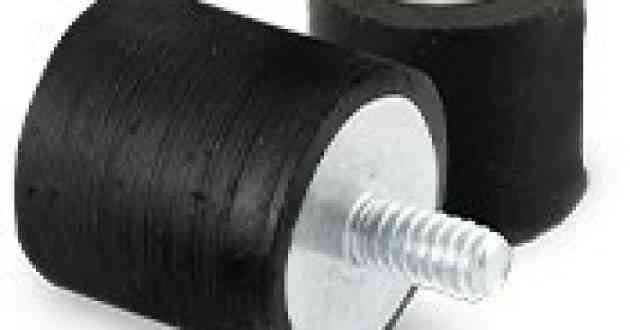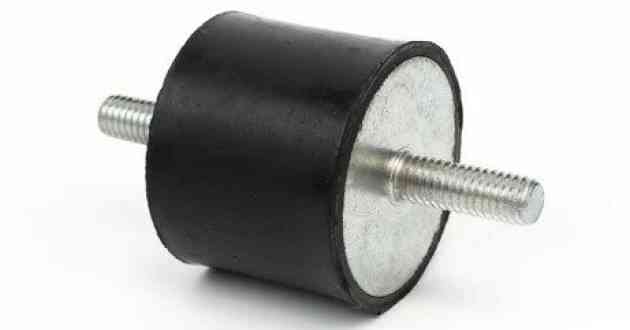Guide To Rubber Isolator Bushings: Everything You Need To Know
- - Category: Industrial
- - 26 Sep, 2023
- - Views: 253
- Save

Rubber isolator bushings: The key to effective vibration control. Learn more and improve performance today!
Rubber isolator bushings are essential components in various industries, providing vital vibration control and isolation. These bushings play a crucial role in reducing noise, preventing equipment damage, and enhancing overall performance. In this comprehensive guide, we will explore the world of rubber isolator bushings, including their functionality, types, benefits, installation process, troubleshooting tips, maintenance, and commonly asked questions.
What Are Rubber Isolator Bushings and How Do They Work?
Rubber isolator bushings, also known as rubber vibration isolators or isolation bushings, are designed to absorb and minimize vibrations in machinery, equipment, and structures. These bushings act as a barrier between two components, providing a cushioning effect and isolating vibrations from one part to another. They are made from high-quality rubber compounds, which offer excellent elasticity and resilience.
The working principle of rubber isolator bushings involves the conversion of vibrational energy into heat energy. When a machine or equipment generates vibrations, the rubber bushings compress and deform, absorbing the energy and dissipating it as heat. This process effectively reduces the transmission of vibrations, preventing their propagation to surrounding components.
The Importance of Rubber Isolator Bushings in Vibration Control
Vibration control is crucial in various industrial applications, as excessive vibrations can lead to equipment failure, increased maintenance costs, and compromised safety. Rubber isolator bushings play a vital role in mitigating these issues by offering effective vibration control and isolation. Here are some key reasons why these bushings are essential:
- Reduced Noise: Vibrations can generate unwanted noise, causing discomfort and disturbance in the working environment. Rubber isolator bushings absorb vibrations, minimizing noise levels and creating a quieter and more comfortable atmosphere.
- Equipment Protection: Excessive vibrations can damage sensitive components and equipment, leading to premature wear and tear. By isolating vibrations, rubber bushings protect equipment from potential damage, extending their lifespan and reducing the need for costly repairs.
- Enhanced Performance: Vibrations can negatively impact the performance of machinery and equipment, affecting their accuracy and efficiency. Rubber isolator bushings help maintain stability and minimize vibrations, resulting in improved overall performance.
- Worker Safety: Excessive vibrations can pose risks to the health and safety of workers. Prolonged exposure to vibrations can cause fatigue, musculoskeletal disorders, and other health issues. Rubber isolator bushings reduce vibrations, creating a safer working environment for personnel.
Different Types of Rubber Isolator Bushings Explained
Rubber isolator bushings are available in various types, each designed to cater to specific applications and requirements. Understanding the different types can help you choose the right bushings for your needs. Let's explore the most common types of rubber isolator bushings:
- Cylindrical Bushings: Cylindrical bushings are the most basic type of rubber isolators. They feature a simple cylindrical shape with a hole in the center for mounting. These bushings provide excellent vibration isolation in both axial and radial directions.
- Conical Bushings: Conical bushings, also known as tapered or stepped bushings, have a tapered shape, with one end larger than the other. This design allows for effective vibration isolation in applications where axial movement is involved. Conical bushings are commonly used in automotive and heavy machinery applications.
- Bonded Bushings: Bonded bushings consist of two metal plates bonded together with a rubber compound in between. This design provides enhanced stability and isolates vibrations effectively. Bonded bushings are suitable for applications where high load capacity and durability are required.
- Shear Bushings: Shear bushings, also known as shear mounts, are designed to provide excellent vibration isolation in shear directions. They feature a combination of rubber and metal components, allowing for both vertical and horizontal flexibility. Shear bushings are commonly used in HVAC systems, generators, and industrial machinery.
- Damped Bushings: Damped bushings incorporate additional damping materials within the rubber compound to further reduce vibrations. These bushings are highly effective in applications that require superior vibration control and isolation, such as precision instruments and delicate electronic equipment.
Benefits of Using Rubber Isolator Bushings in Industrial Applications
Using rubber isolator bushings in industrial applications offers a wide range of benefits. Let's explore some of the key advantages:
- Vibration Control: Rubber isolator bushings effectively control and isolate vibrations, ensuring smooth operation and minimizing the transmission of vibrations to surrounding components.
- Noise Reduction: By absorbing vibrations, rubber bushings significantly reduce noise levels, creating a quieter and more comfortable working environment.
- Equipment Protection: Rubber isolator bushings protect machinery and equipment from excessive vibrations, preventing damage and extending their lifespan.
- Improved Performance: By minimizing vibrations, rubber bushings enhance the performance of machinery and equipment, resulting in increased accuracy, efficiency, and productivity.
- Cost Savings: By reducing equipment damage and maintenance requirements, rubber isolator bushings help save costs in the long run. They also minimize downtime and improve overall operational efficiency.
Factors to Consider When Choosing the Right Rubber Isolator Bushings
Choosing the right rubber isolator bushings for your specific application is crucial to ensure optimum performance and effectiveness. Consider the following factors when selecting bushings:
- Load Capacity: Evaluate the load capacity requirements of your application. Choose bushings that can handle the expected load without experiencing excessive deformation or failure.
- Vibration Frequency: Identify the vibration frequency range of your equipment or machinery. Select bushings that offer effective vibration isolation within that specific frequency range.
- Environmental Conditions: Consider the environmental conditions, such as temperature, humidity, and exposure to chemicals or oils. Choose bushings that are compatible with the operating environment to ensure durability and longevity.
- Mounting Method: Determine the appropriate mounting method for your application. Consider factors such as space constraints, ease of installation, and the type of equipment or structure you are working with.
- Application Requirements: Understand the specific requirements of your application, such as axial movement, shear resistance, or damping capabilities. Select bushings that align with these requirements to ensure optimal performance.
Step-by-Step Guide: How to Install Rubber Isolator Bushings
Installing rubber isolator bushings is a straightforward process. Follow these step-by-step instructions for a successful installation:
- Assess the Mounting Points: Identify the mounting points where the bushings will be installed. Ensure that the surfaces are clean, free from debris, and properly aligned.
- Prepare the Bushings: Inspect the rubber isolator bushings for any damage or defects. Ensure that they are the correct size and type for your application. Lubricate the bushings if necessary, following the manufacturer's recommendations.
- Align and Position the Bushings: Carefully align the bushings with the mounting points. Insert them into the designated holes, ensuring a snug fit. Use a mallet or suitable tool to gently tap the bushings into place if needed.
- Secure the Bushings: Once the bushings are properly positioned, secure them using the appropriate hardware, such as bolts, nuts, or washers. Tighten the hardware to the recommended torque specifications, ensuring a secure and stable installation.
- Check for Proper Alignment: Double-check the alignment and positioning of the installed bushings. Ensure that they are evenly distributed and provide adequate clearance for any required movement.
- Test and Inspect: After installation, test the equipment or machinery to ensure proper functionality. Monitor for any signs of excessive vibrations or unusual noise. Regularly inspect the bushings for wear, damage, or deterioration, and replace them as needed.
Common Issues and Troubleshooting Tips for Rubber Isolator Bushings
While rubber isolator bushings are designed to provide effective vibration control and isolation, certain issues may arise. Here are some common problems and troubleshooting tips:
- Excessive Vibrations: If you notice excessive vibrations despite the presence of rubber isolator bushings, check for worn or damaged bushings. Replace any faulty bushings to restore proper vibration control.
- Noise Generation: If the rubber bushings are generating noise, inspect them for signs of wear or deterioration. Lubricate the bushings if necessary. If the noise persists, consider using damped bushings for superior noise reduction.
- Premature Bushing Failure: If the rubber isolator bushings fail prematurely, evaluate the load capacity and compatibility with the application requirements. Ensure that the bushings are properly selected and installed according to the manufacturer's guidelines.
- Improper Alignment: Improper alignment of the bushings can lead to reduced effectiveness and potential damage. Double-check the alignment during installation and make necessary adjustments to ensure proper alignment.
How to Maintain and Extend the Lifespan of Rubber Isolator Bushings
Proper maintenance is essential to extend the lifespan of rubber isolator bushings and ensure their optimal performance. Here are some maintenance tips:
- Regular Inspection: Regularly inspect the rubber bushings for signs of wear, damage, or deterioration. Replace any worn or damaged bushings promptly to prevent further issues.
- Cleaning: Keep the rubber bushings clean by regularly removing dirt, dust, and debris. Use a soft brush or cloth to gently clean the surfaces. Avoid using harsh chemicals or solvents that may degrade the rubber.
- Lubrication: Lubricate the rubber bushings as recommended by the manufacturer. Lubrication helps reduce friction and prolong the lifespan of the bushings. Use a suitable lubricant that is compatible with the rubber material.
- Environmental Protection: Protect the rubber isolator bushings from extreme temperatures, chemicals, oils, and other potentially damaging substances. When possible, shield the bushings with appropriate covers or enclosures.
Frequently Asked Questions About Rubber Isolator Bushings Answered
- Q: Are rubber isolator bushings suitable for both small and large-scale industrial applications?
A: Yes, rubber isolator bushings are used in a wide range of industrial applications, regardless of scale. They can be found in small machinery, heavy equipment, automotive vehicles, HVAC systems, and more.
- Q: Can rubber isolator bushings be used outdoors?
A: Yes, rubber isolator bushings can be used outdoors. However, it is important to select bushings that are specifically designed for outdoor use and can withstand exposure to UV rays, moisture, and temperature fluctuations.
- Q: How frequently should rubber isolator bushings be replaced?
A: The replacement frequency of rubber isolator bushings depends on various factors, such as the application, load capacity, environmental conditions, and maintenance practices. Regularly inspect the bushings for signs of wear or deterioration, and replace them as needed.
- Q: Can I install rubber isolator bushings myself, or should I seek professional help?
A: The installation of rubber isolator bushings can typically be done by following the manufacturer's guidelines and using basic tools. However, if you are unsure or dealing with complex machinery, it is advisable to seek professional assistance to ensure a proper installation.
In conclusion, rubber isolator bushings are indispensable components in vibration control and isolation. They offer numerous benefits, including noise reduction, equipment protection, improved performance, and worker safety. By understanding the different types, choosing the right bushings, following proper installation procedures, and maintaining them regularly, you can optimize the performance and longevity of rubber isolator bushings in your industrial applications.


